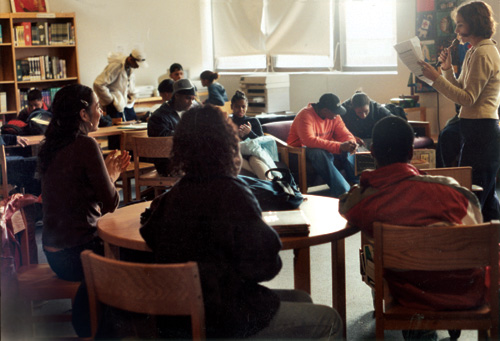A Curriculum Staple: Reading Aloud to Teens

Dana Johansen, a teacher at the Greenwich (CT) Academy, reads to eighth graders.
Photo courtesy of Greenwich Academy.
Every year, Beth Aviv, a high school English teacher in Westchester County, NY, asks her students, “How many of you were read to by a parent when you were little?” Last year, only a quarter of the class raised their hands. Aviv discovered these students were starved for storytelling. So she read to them often, from classic novels such as F. Scott Fitzgerald’s The Great Gatsby, picture books including Margery Williams’s The Velveteen
Rabbit, and Lynda Blackmon Lowery’s Turning 15 on the Road to Freedom: My Story of the Selma Voting Rights March (Dial, 2015). Students were “rapt,” said Aviv. “They didn’t want me to stop.”
Young people often listen at a higher comprehension level than they read, according to Jim Trelease, author of The Read-Aloud Handbook (Penguin, 1982), a best seller with more than two million copies sold, and now in its seventh edition. While some educators may view reading aloud as a step backward pedagogically, or not the most productive use of class time, reading aloud can advance teens’ listening and literacy skills by piquing their interest in new and/or rigorous material. It also builds what Trelease calls the “pleasure connection” between the young person and the book and the person reading aloud.
Perhaps not surprisingly, Scholastic’s Kids & Family Reading Report, 5th edition, based on a survey conducted in the fall of 2014, correlates high reading enjoyment with reading frequency in students ages six to 17. The report also found that among children ages six to 11 whose parents had stopped reading to them at home, 40 percent did not want the practice to end.
Trelease believes that reading aloud to students beyond the eighth grade is important because these students rarely experience the printed word without an accompanying assignment, creating what he refers to as a “sweat mentality” around books. And the older the student, the more work they are asked to do around reading. Children’s belief that reading for fun is “extremely important” typically drops off after age eight, according to the Scholastic report, and one more reason why educators need to ramp up their practice rather than pull away. “When you read aloud to anyone, it’s a commercial for the pleasures of reading,” notes Trelease.
Dana Johansen, a fifth-grade English teacher with experience working with grades four to eight at Greenwich (CT) Academy, recommends reading aloud to older students from the first title in a series. “That way they’ll want to continue on their own,” says Johansen, who is also coauthor with Sonja Cherry-Paul of Teaching Interpretation: Using Text-Based Evidence to Construct Meaning (Heinemann, 2014). When reading aloud a book by Judy Blume, Johansen’s students brainstormed questions they wanted to ask Blume, tweeted her, and received a personal response. Sharing the listening experience enabled her students to address topics they deemed “important” and “awkward” under the guidance of an adult.
Reading aloud also offers an opportunity for classroom teachers to gauge students’ comprehension. Aviv alternates between reading aloud and asking students to do so. When someone stumbles over a word, she invites the class to define it. Sometimes, the educator pauses to take questions.
North Dakota librarian Doreen Rosevold, who works with grades 6–12, agrees with Aviv that reading aloud deepens understanding. “Students hear word pronunciations and inflections that they might miss in their own reading, and in listening to them, they create mental images.” Rosevold’s school in Mayville, ND, serves 304 local tweens and teens from four rural communities. Rosevold believes that reading aloud also puts listeners “on a more level playing field,” since reading ability is not a factor.

Sara Lissa Paulson (right) reads aloud from Dr. Jekyll and Mr. Hyde.
Photo courtesy of Sara Lissa Paulson
Making room for read-alouds
Middle and high school libraries are often bustling places, hosting multiple activities at any given time. When teacher librarian Sara Lissa Paulson read aloud from Robert Louis Stevenson’s The Strange Case of Dr. Jekyll and Mr. Hyde, she didn’t cancel any of the other happenings in the middle school library where she then worked in Queens, NY. She posted fliers around school and notified the community about the event, but did not expect a formal audience. One by one, more students became swept up in the story, and pulled up chairs. By the end of the novella, Paulson had 20 listeners.
Read-alouds as special occasions
Read-alouds can be festive occasions—even sleepover parties. All Night Reading has been a decade-long tradition at St. Ann’s School in Brooklyn, NY. The current organizer, Sam Aronson, an English and a math teacher, invites high school students, their families, and the school community to listen to one another read classics such as Homer’s The Iliad, Ralph Ellison’s Invisible Man, and Gabriel García Márquez’s One Hundred Years of Solitude in their entirety. The annual spring event is held in the cafeteria, beginning on a Friday afternoon. The first reading session ends around 2 a.m. After a sleep break, readers resume Saturday morning and continue to midday. Literary meals are served (fish chowder for Herman Melville’s Moby-Dick and beef stroganoff for Fyodor Dostoyevsky’s Crime and Punishment). Almost 200 people participate, with 40 to 50 typically spending the night.
Aronson describes the program as “a challenge and an opportunity [for students] to experience a book that they might not otherwise,” adding that the event creates “a real sense of intellectual community.”
Some teen librarians incorporate read-alouds into seasonal celebrations. Rosevold reads Edgar Allan Poe’s story “The Tell-Tale Heart” around an electric fireplace, using props such as a plastic heart in a jar, and she pulls a plastic mallet out from her sleeve during a dramatic moment. Other librarians hold birthday parties for authors or celebrate the anniversary of a book’s publication. Making reading a social experience lends them “value,” says Paulson.
During Paulson’s “Reading in the Streets” day, members of the school community read aloud in the hallways as students moved from class to class. The principal read from Lewis Carroll’s Alice’s Adventures in Wonderland (and dressed up as Alice); a security guard read from Moby-Dick. The voices of teachers and guidance counselors could be heard throughout the corridors. In the few minutes of transitional time, students listened to snippets of stories, absorbed rich language, and made new connections to staff members and the books they loved.
Stress-free books
The visual richness and often hidden complexity of picture books make them ideal for teens, as Linda Jacobson wrote in a recent article for SLJ. Olga Nesi, the newly appointed librarian at Boys and Girls High School in Brooklyn, NY, plans to build a picture book collection for read-alouds, research, and countless other purposes. During her 22 years as an educator, many of the teens Nesi has worked with initially “balked at being read to” or described picture books as “babyish.” Partly for this reason, the librarian started referring to the books as “stress-free reading.”
Once her students acclimated to regular read-alouds, they loved them. Nesi’s picture book collections have helped her students gain quick access to different genres and historical eras, and served as mentor pieces. Patricia Polacco’s Pink and Say (Philomel, 1994) was among a stack of titles about the Civil War.
Students who hear picture books aloud often ask to borrow them to read to siblings at home. Trelease writes movingly in his Handbook about a teen parent who began reading to his son after his positive experiences with read-alouds in high school.
“This generation wasn’t read to the way we were,” says Aviv. But it’s never too late to reverse this trend.
“When we stop creating lifetime readers, we endanger the entire culture,” states Trelease. Read a first chapter, and students “will want to know what happens next. It’s part of the human condition. We all want to know what comes next.”
Add Comment :-
RELATED
The job outlook in 2030: Librarians will be in demand
The job outlook in 2030: Librarians will be in demand
ALREADY A SUBSCRIBER? LOG IN
We are currently offering this content for free. Sign up now to activate your personal profile, where you can save articles for future viewing


 Jess deCourcy Hinds is the librarian at Bard H.S. Early College in Queens, NY.
Jess deCourcy Hinds is the librarian at Bard H.S. Early College in Queens, NY.




